Puran Poli is a popular Maharashtrian sweet flatbread stuffed with lentils, and jaggery and flavored with cardamom and saffron. It is commonly made during Indian festivals like Holi and Ganesh Chaturthi. Puran Poli is best served with a generous dollop of ghee and milk on the side to dip.
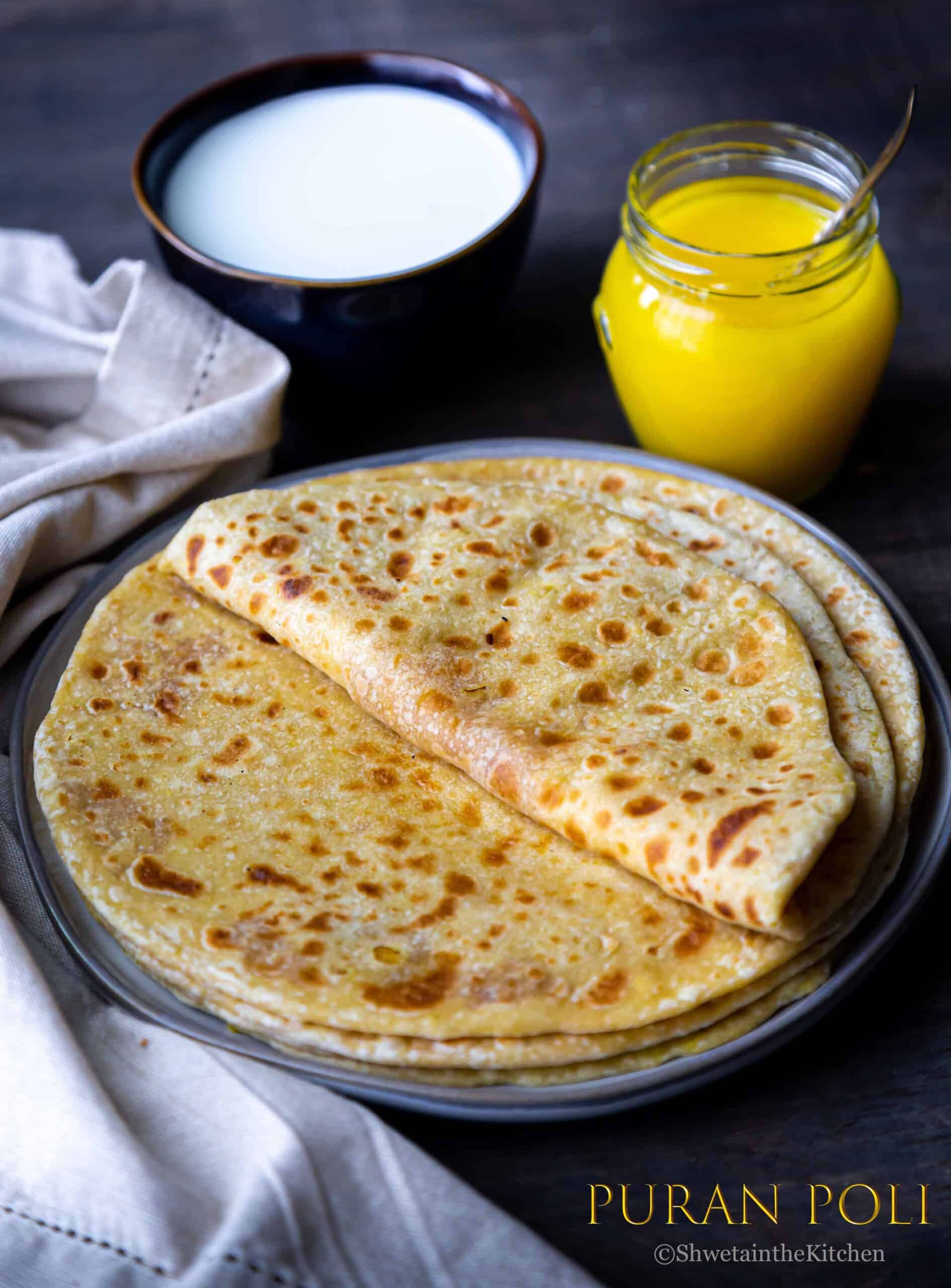
"Holi re holi, puranachi poli", are the words that come to my mind when I hear the word puran poli. I associate this Maharashtrian delicacy with the Indian festival of Holi as that's when my aaji (grandmom) and mom made these melt-in-mouth soft puran polis.
Puran poli is also made during Ganesh Chaturthi and other festival in different states of India.
My kids love this sweet lentil paratha and we eat them for breakfast or snack.
This recipe brings back so many childhood memories and I'm so thrilled to share this traditional Maharashtrian puran poli recipe with you all. If you love this sweet puran poli, try the Sanjori recipe too!
Jump to:
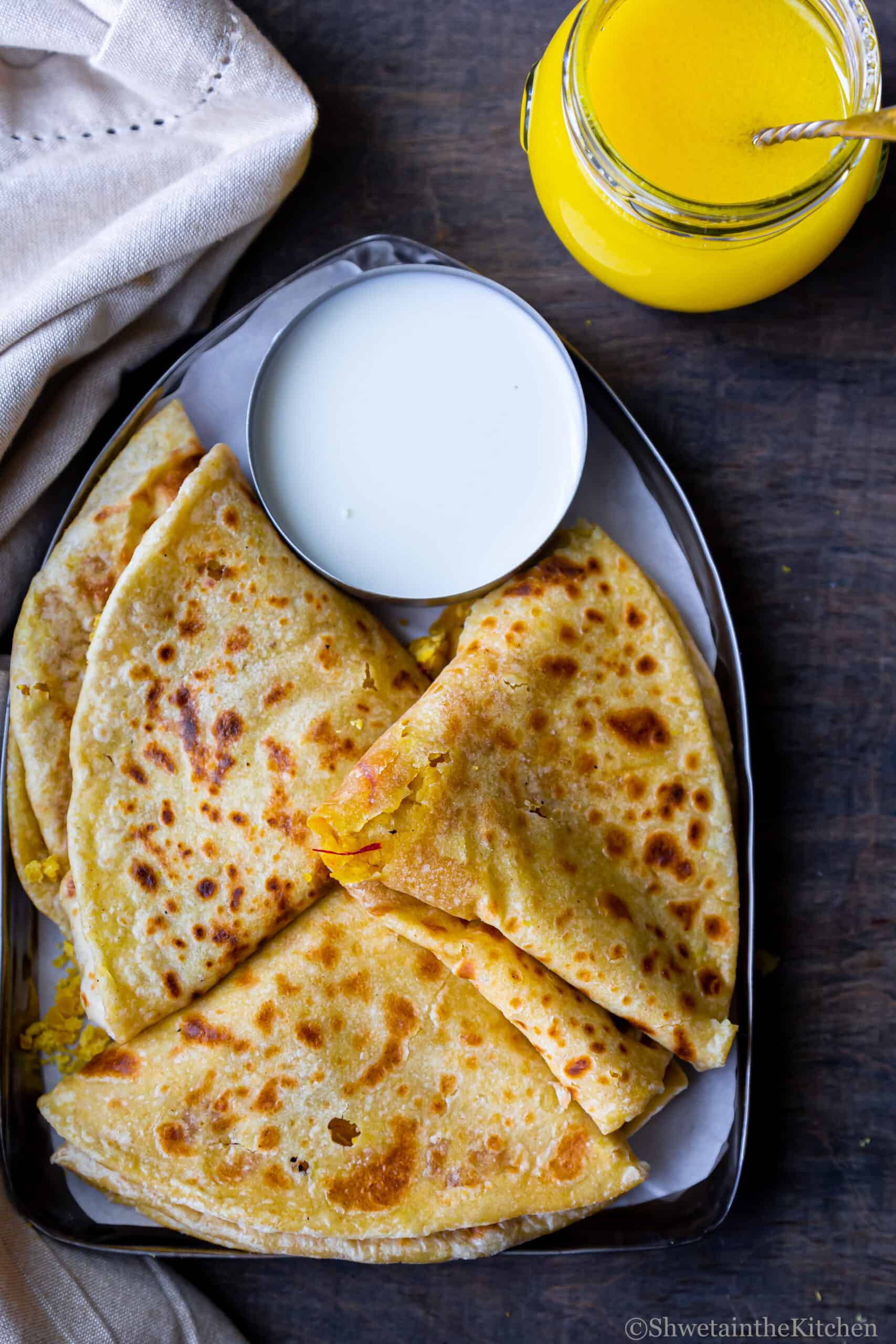
What is Puran Poli
Puran Poli is a traditional Indian sweet flatbread from the state of Maharashtra.
Many states have different names for this recipe, in Gujarat, it is called Vedmi and is made with Toor dal instead of chana dal.
The Marathi word Puran stands for sweet stuffing and Poli for flatbread. So Puran Poli means sweet lentil stuffed flatbread.
Puran is a soft sweet stuffing made with cooked chana dal (split yellow Bengal gram), sweetened with jaggery, and flavored with saffron, cardamom, and nutmeg.
The dough is made with whole wheat flour and all-purpose flour.
Puran poli is cooked in pure ghee and served with more ghee or milk or Katachi aamti.
It is popularly made during Indian festivals like Holi, Ganesh Chaturthi, and Gudi Padwa.
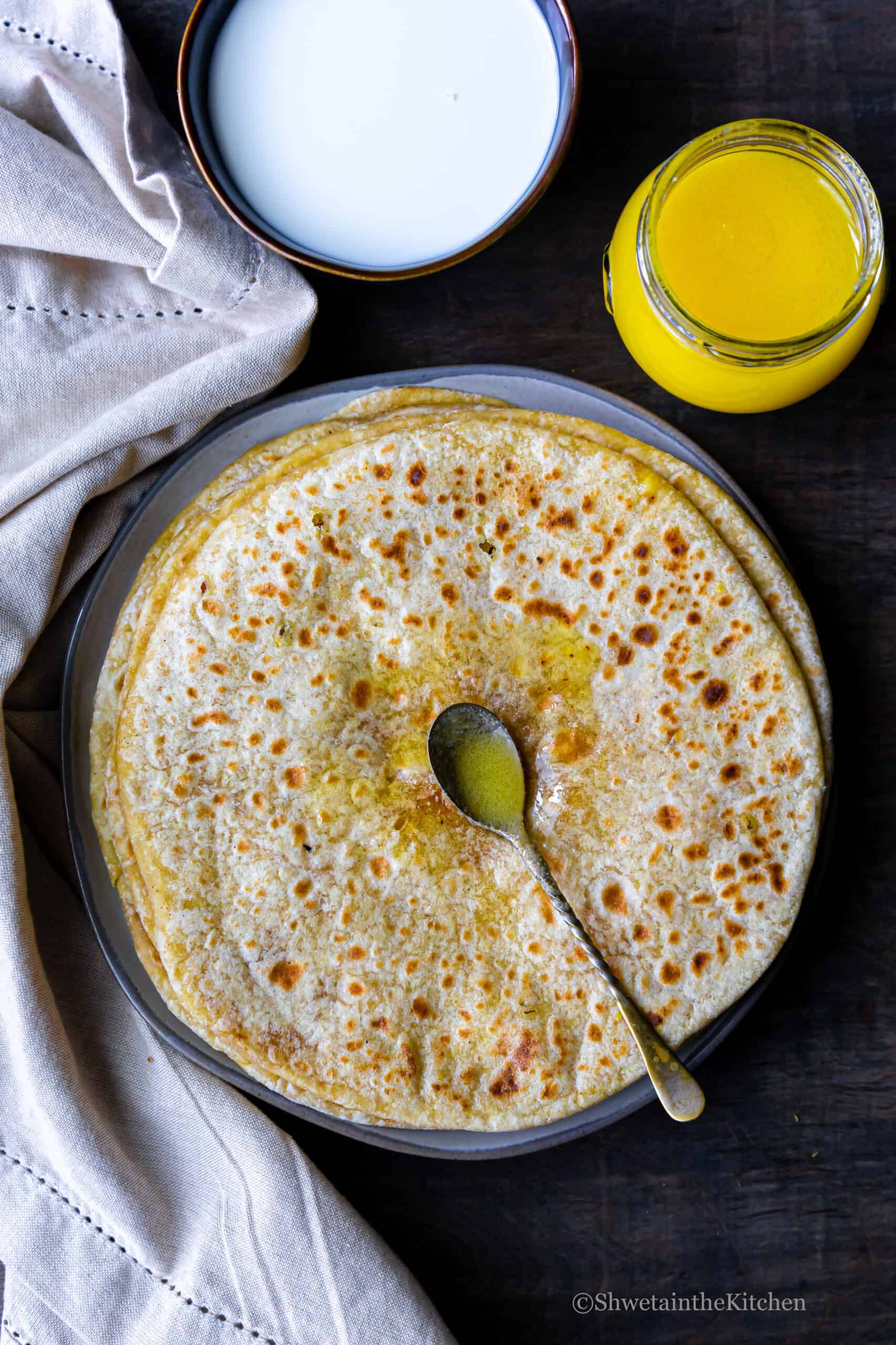
How To Make Puran Poli (Stepwise photos)
The recipe for puran poli may look intimidating but it's really not. It does require some time and effort but the outcome is so delicious that it's worth the effort!!
To summarize the steps needed to make puran poli - You need to make the Puran and dough and then stuff this puran in the dough, roll it in a circle, and then roast them.
Making Puran

Rinse the chana dal 2-3 times and soak it for 2-4 hours. Drain the water and add it to the instant pot along with turmeric, salt, and 2 cups of water. Close the lid with the vent in the sealing position.
Pressure cook on manual high for 20 mins (6-7 whistles on medium-low in a traditional pressure cooker). Allow natural release.
Note: If you haven't soaked your dal, pressure cook on manual high pressure for 30 minutes.
Strain the water and reserve it to make Katachi Amti or use it for kneading dough.
Start the instant pot on saute (normal) mode. Add ghee to it along with the cooked dal. Mash the dal either with the back of your spoon or using a hand blender (preferred) to make it almost smooth.

Add jaggery to the mashed chana dal and mix well. The mixture will turn wet once the jaggery melts so cook for 5-10 mins until the mixture dries (yet is soft).
Switch off the Instant Pot, remove the container, and keep it aside or else it will continue to cook and dry out the puran.
This is how my Mom tests to see if puran is ready, if your spoon stands straight in the puran and does not fall then the mixture is ready (pic 2 from left).
At this point add the cardamom and nutmeg powder along with saffron strands and give it one final mix until well combined.
If you feel the mixture has dried out, add some ghee and a splash of milk and adjust the consistency. Allow the mixture to cool completely and then divide it into 8 balls. Keep aside covered.
Making dough

While the Puran cooks, make the dough by mixing the flour, turmeric powder, and salt together. Add oil and about 1 cup water (you may need a couple of tablespoons more depending on the flour used) and knead to form a soft and smooth dough. Apply oil and knead again. Cover airtight or with a wet cloth and keep aside.
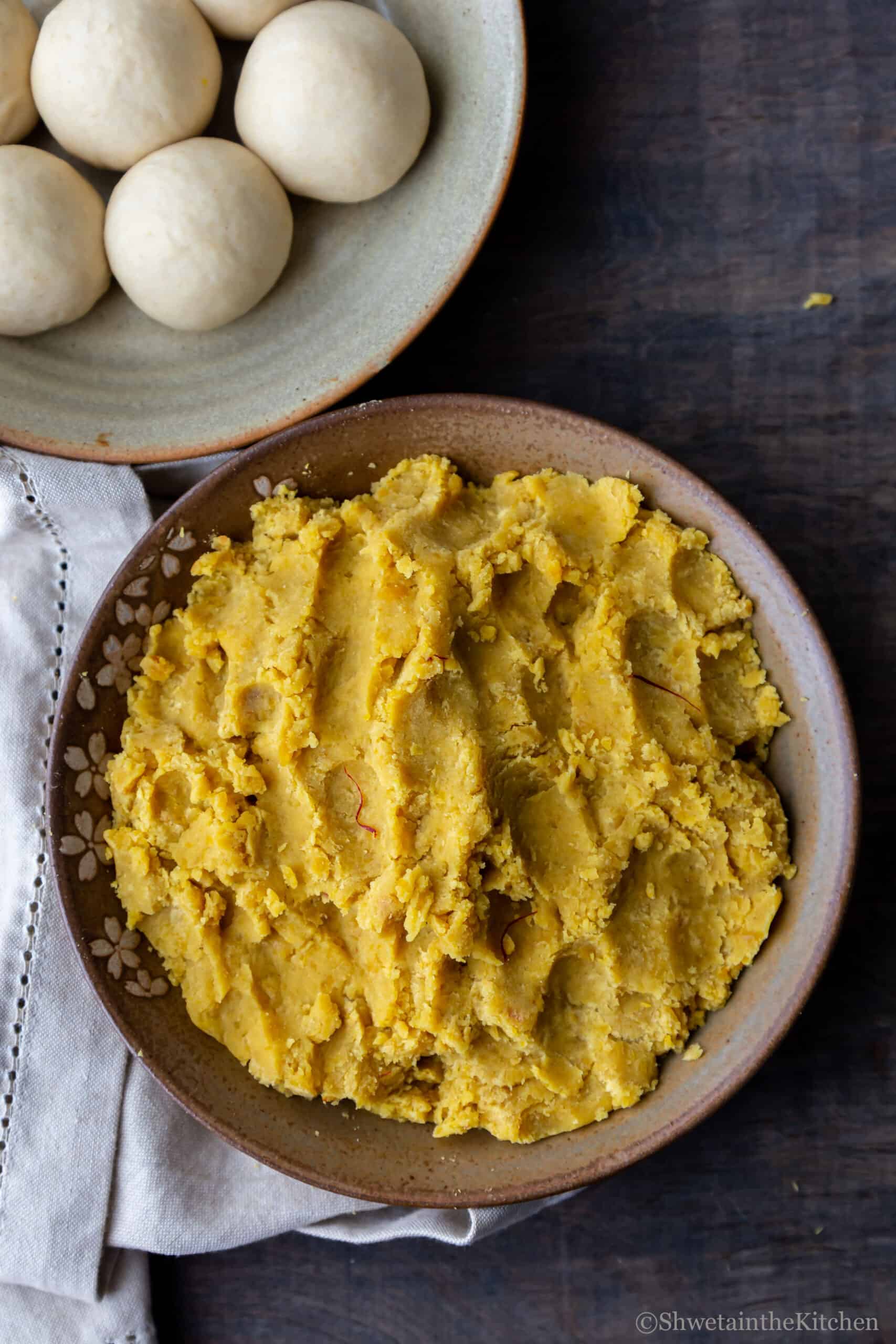
Making Puran Poli

Knead the dough once again, and divide the dough into 8 balls. Heat the griddle (tawa) on medium heat. Take one dough ball, dip it in rice flour, and then using a rolling pin make it into a 3-4 inch diameter circle. You can also use wheat flour for rolling.

Place the puran ball in the center of the rolled dough. The quantity of puran should be more than dough. Gather all the edges towards the center to enclose the stuffing and pinch them together to seal/close. Flatten the stuffed dough slightly

Dip in rice flour and then gently roll it thin into 8-9 inch diameter. Gently transfer the rolled flatbread (poli) onto the hot griddle. Once you see bubbles, flip the poli.

Cook the other side until it's golden brown and then flip again and finish cooking the first side until it's nice and golden. Transfer to a plate and apply a generous amount of ghee. Similarly, make the remaining polis.
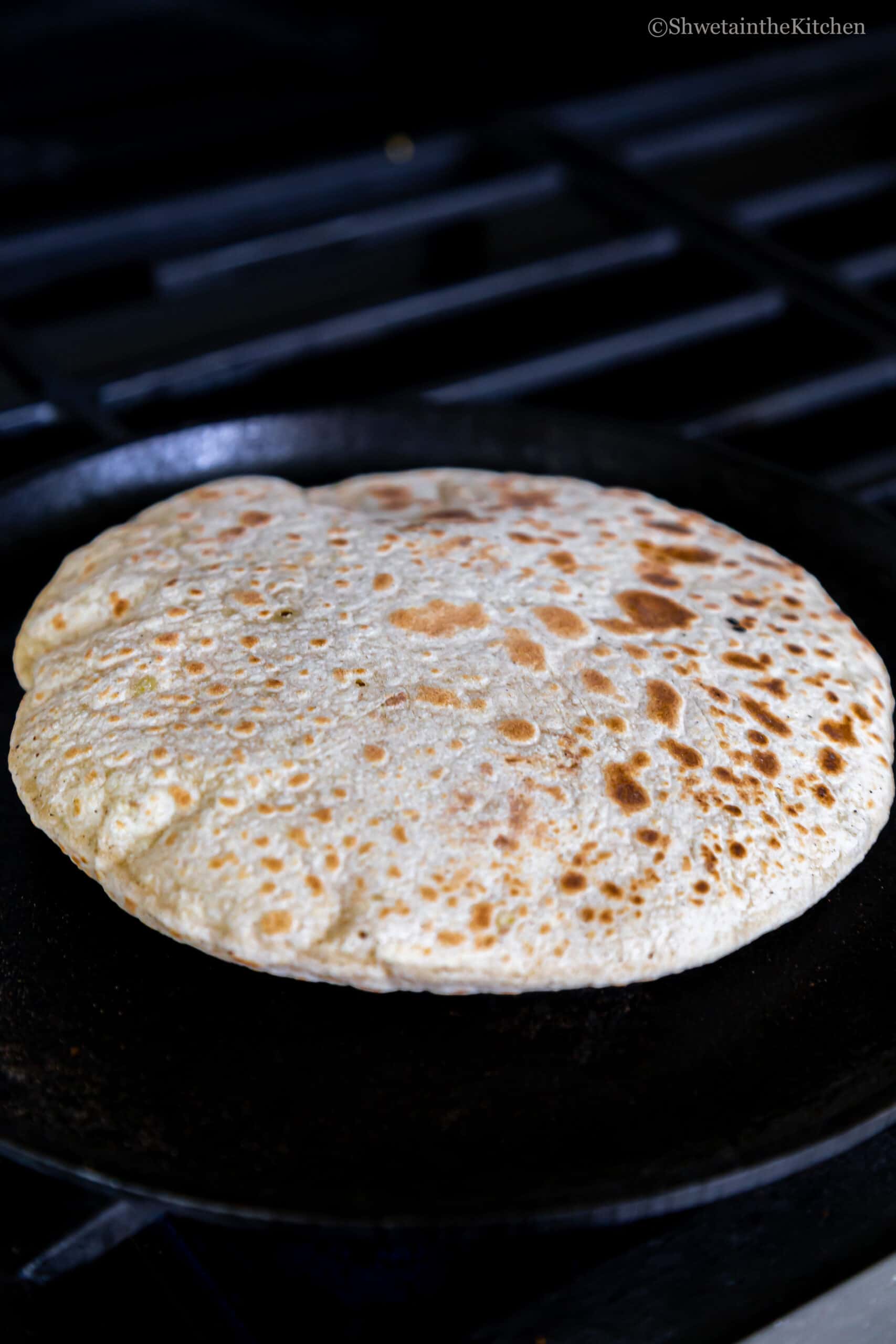
Serving Suggestion
Traditionally Puran Poli is served slathered with ghee since chana dal is heavy to digest and ghee makes the process easier.
It's also served with a side of milk or a savory curry called Katachi Amti which is made from the water left over after cooking the chana dal (lentils).
You can serve Puran Poli for breakfast or snack and it's a great option for kids lunchboxes too!
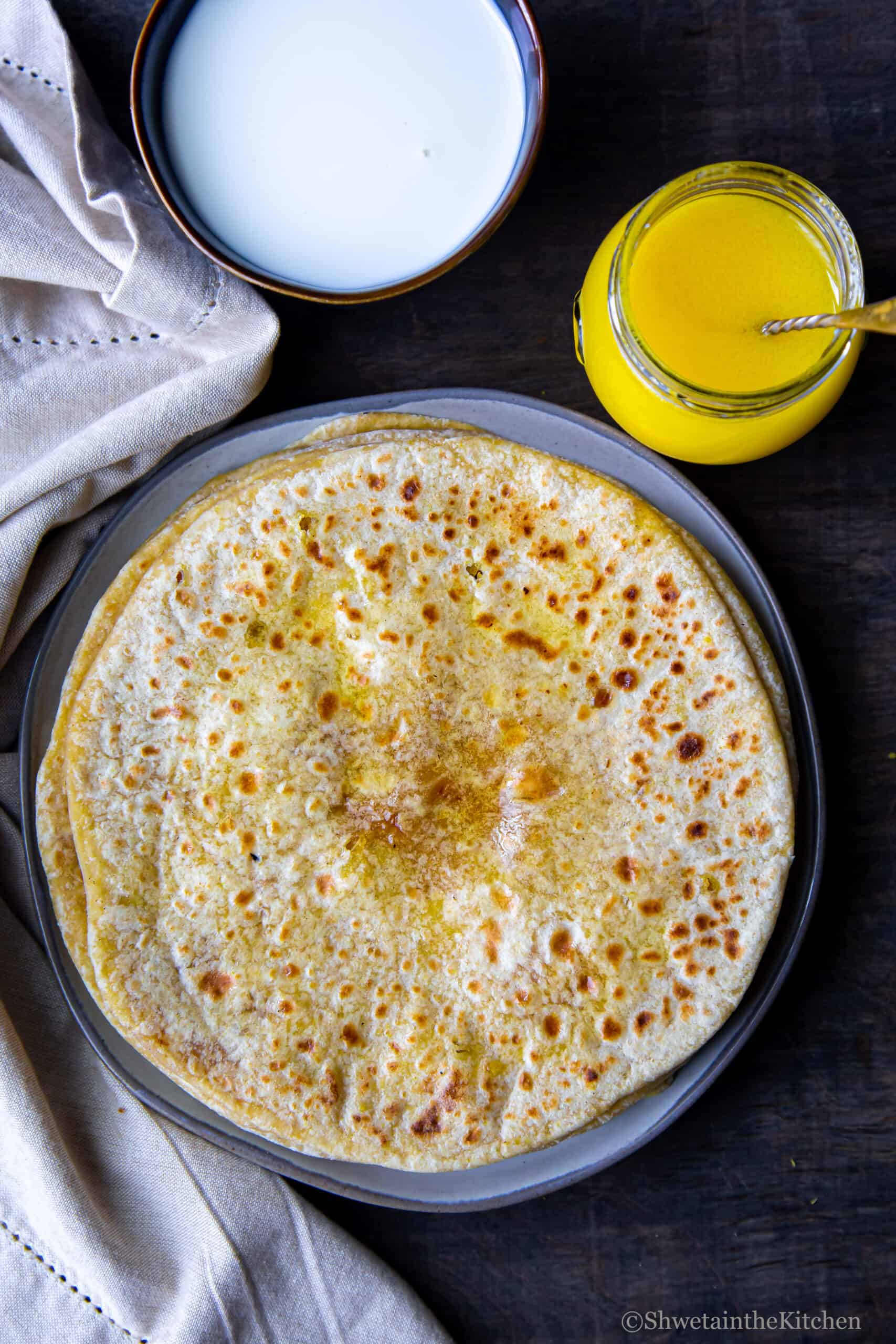
Storage Instructions
For storing, puran poli can stay at room temperature when kept covered in an airtight container. For longer, I would suggest keeping them in the refrigerator and/or freezing them.
When refrigerated, they might turn stiff due to all the ghee and lentils solidifying. Just warm them back on a griddle or microwave until warm and soft. Slather with some more ghee and serve.
Recipe Tips
Soak the dal for at least 2 hours in hot water or 4 hours. This helps the dal cook faster and become softer.
Ensure that the dal is cooked until it's very soft and mushy. Undercooked dal can result in a grainy texture in the puran.
Blend puran it into a smooth paste using a spoon or blender or immersion blender. This ensures a uniform texture.
You can use either jaggery or sugar for sweetness. Jaggery is more traditionally used and adds a unique flavor to the puran. You can use a combination of jaggery and sugar too.
1 cup of jaggery gives the right amount of sweetness, but if you like it more sweet add ¼-1/2 cup more or to taste.
Puran consistency needs to be right, if it's too wet the poli will tear while rolling and if ts too dry it will be crumbly. One trick is to check the Puran by placing a spoon, if your spoon stands straight in the puran and does not fall then it's ready.
You can use whole wheat flour, all-purpose flour, or a combination of both. I find the ratio mentioned in the recipe works best.
Using wheat flour alone is healthier and easier to roll. If you use only all-purpose flour the rolling process might get a little difficult and also I find the poli becomes chewy later.
Roll thin polis. This ensures that the puran and dough cook evenly and results in a better texture.
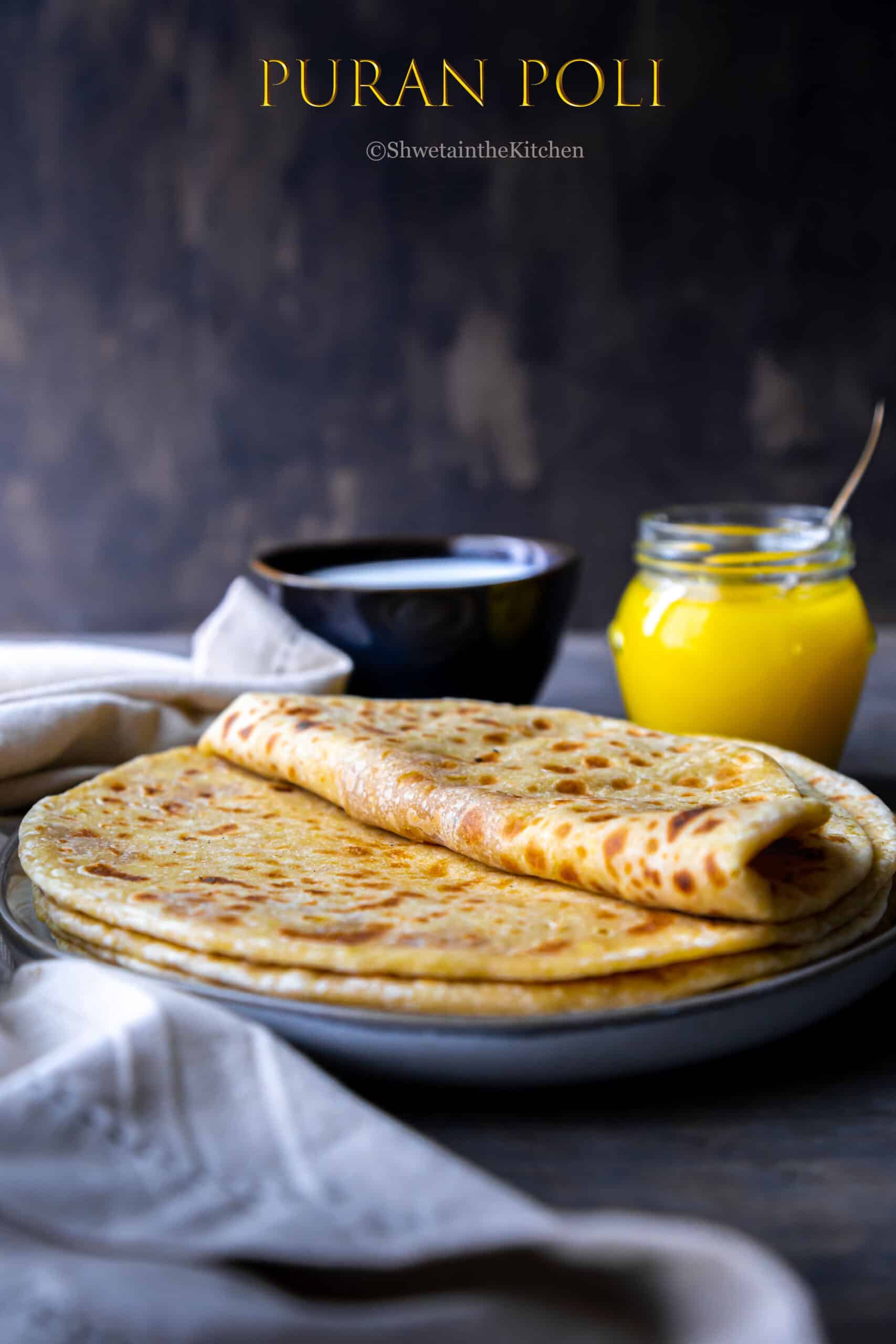
More Holi Recipes
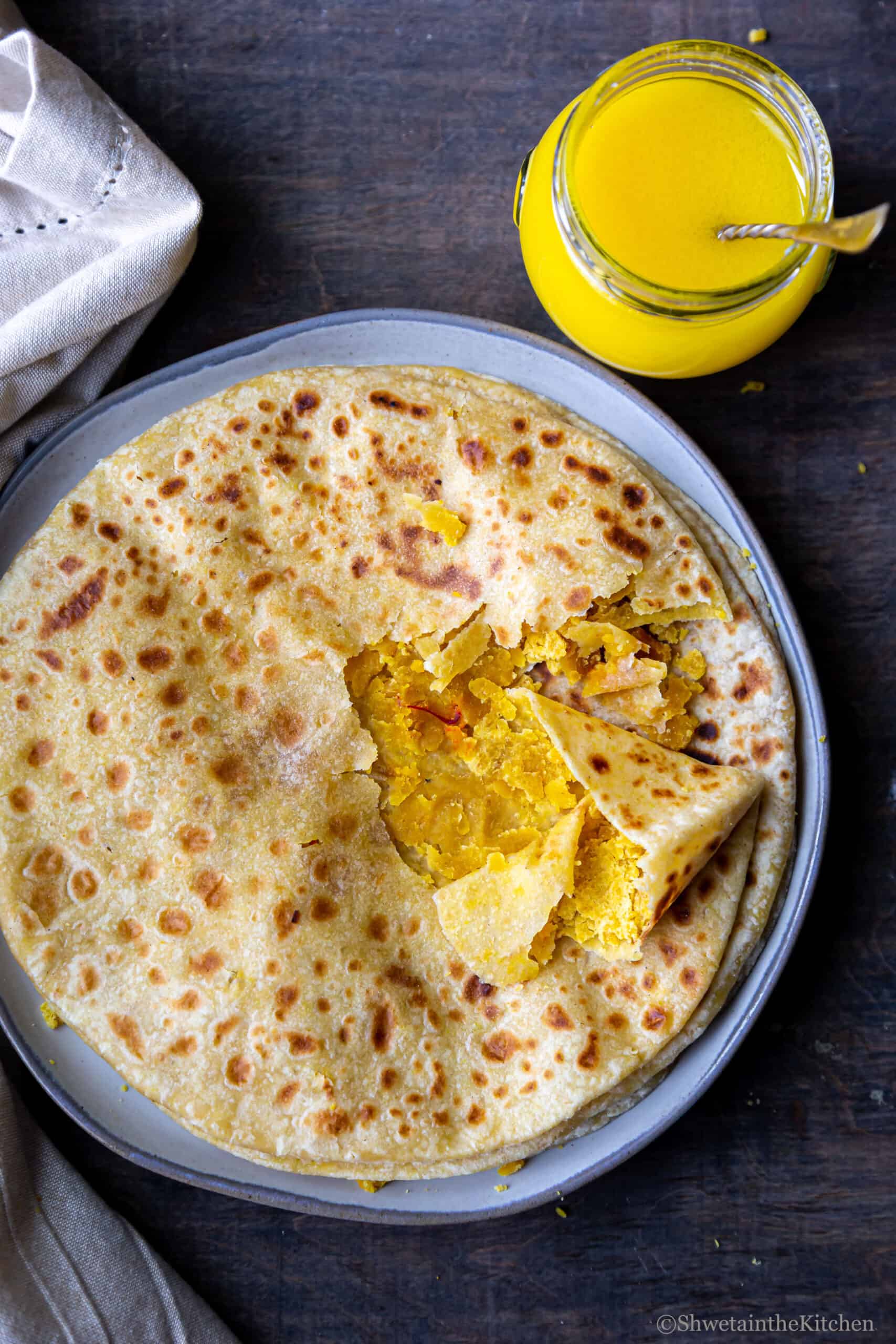
I hope you enjoy this Puran Poli recipe !! If you try this recipe, please rate it by clicking stars ⭐️ on the recipe card. Thank you ❤️! You can also follow me on Facebook and Instagram to see what’s cooking in my kitchen!!
Recipe Card
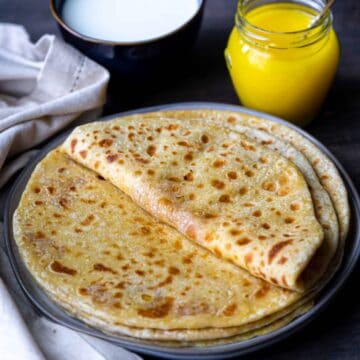
Puran Poli
Equipment
- Pressure cooker
Ingredients
For dough for poli:
- 2 cups wheat flour 240 grams (atta)
- ½ cup all purpose flour 60 grams (maida)
- ⅛ teaspoon turmeric powder
- ¼ teaspoon salt
- 1-2 tablespoon oil or as required
- 1 cup water or as required to make soft dough
- 1 cup rice flour/wheat flour for rolling
For puran (sweet filling/stuffing):
- 1 cup chana dal
- ⅛ teaspoon turmeric powder
- ⅛ teaspoon salt
- ½ teaspoon cardamom powder
- ⅛ teaspoon nutmeg powder
- 1 tablespoon ghee
- 1 cup jaggery shredded/grated
- few strands of saffron optional
Instructions
For making puran in Instant Pot:
- Rinse the chana dal 2-3 times and soak it for 2-4 hours.
- Drain the water and add it to the instant pot along with turmeric, salt and 2 cups of water. Close the lid with vent to sealing and pressure cook on manual high for 20 mins. If you haven’t soaked your dal, pressure cook on manual high pressure for 30mins followed by natural release.
- Strain the water and reserve it to make Katachi Amti or use it for kneading dough.
- Start the instant pot on saute (normal) mode, once hot add ghee to it along with the cooked dal.
- Mash the dal either with back of your spoon or using a hand blender (preferred) to make it almost smooth.
- Add jaggery to the pureed/mashed chana dal and mix well. The mixture will turn wet once the jaggery melts so cook for 5-10 mins until the mixture dries (yet is soft).
- Test the puran, if your spoon stands straight in the puran and does not fall then its ready.
- Switch off the pot and remove the container and keep aside or else it will continue to cook and dry out the puran.
- At this point add the cardamom, nutmeg powder along with saffron strands and give it one final mix until well combined.
- If you feel the mixture has dried out, add some ghee and adjust the consistency. Allow the mixture to cool completely and then divide it into 8 balls.
For making dough :
- While the Puran cooks, make the dough by mixing the flour, turmeric powder and salt together. Add oil and water and knead to form a smooth dough. Apply oil and knead again. Cover airtight or with a wet cloth and keep aside.
For making Puran Poli
- Knead the dough once again, divide the dough too into 8 balls.
- Heat a heavy bottom flat griddle on medium heat. Take one dough ball, dip it in rice flour and the using a rolling pin make it into 3-4 inch diameter circle.
- Place the puran ball in the centre of rolled dough. The quantity of puran should be more than dough. Gather all the edges towards the centre to enclose the stuffing and pinch together to seal/close.
- Flatten the stuffed dough slightly and dip in rice flour and then gently roll it thin into 8-9 inch diameter.
- Gently transfer the rolled flatbread (poli) on to the hot griddle.
- Once you see bubbles, flip the poli. Cook the other side until its golden brown and then flip again and finish cooking the first side until its nice and golden.
- Transfer to a plate and apply generous amount of ghee.
- Similarly make the remaining polis. Serve it with more ghee and milk on the side.


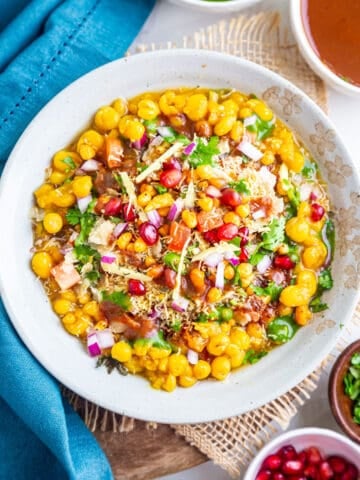
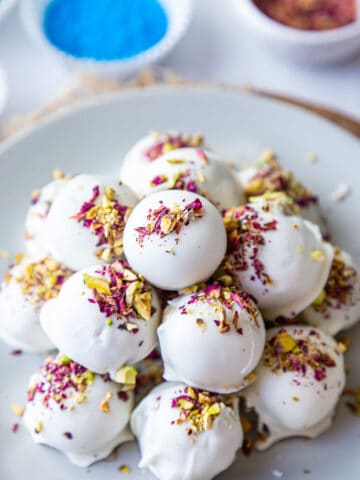
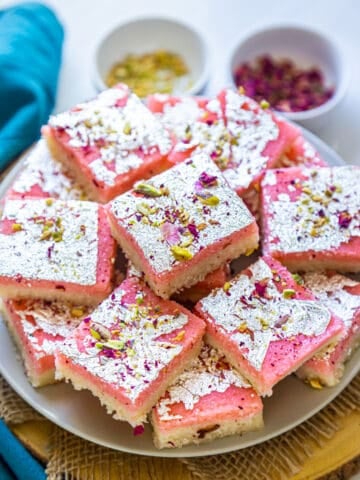
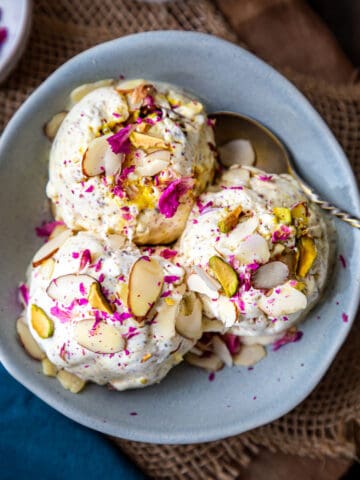

Hi! Would love to try and make this, would I follow the same steps if using toor dhal instead of Channa dhal please? Thanks.
Hi Rita, yes but the cooking time needed to cook toor dal will be different.